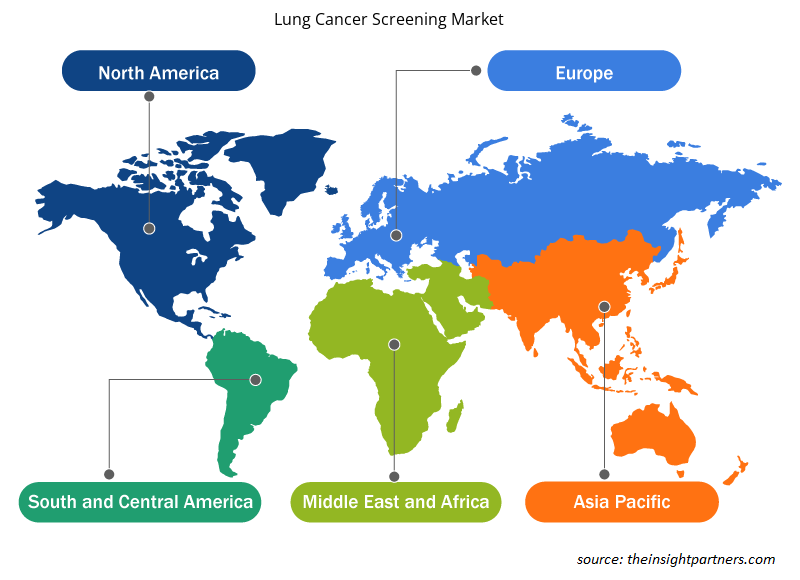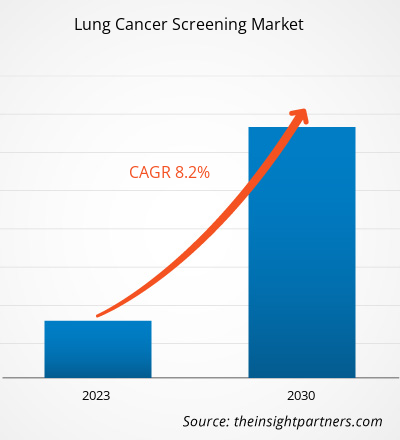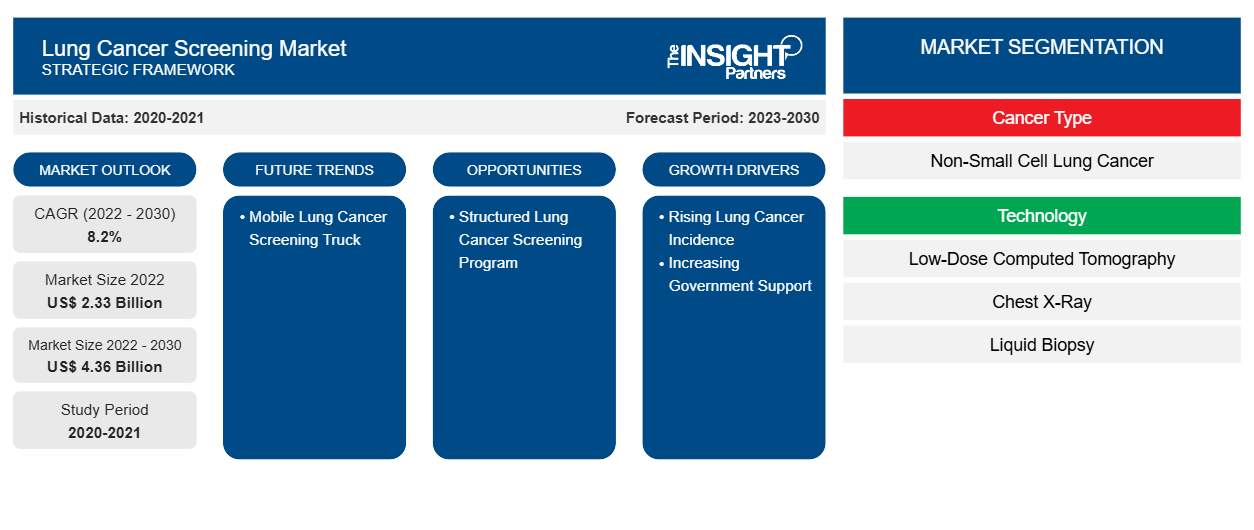[研究报告] 肺癌筛查市场规模预计将从 2022 年的 23.265 亿美元增至 2030 年的 43.6395 亿美元。预计 2022 年至 2030 年的复合年增长率为 8.2%。
分析师观点:
肺癌发病率的上升和政府支持的增加推动了肺癌筛查市场的扩张。随着肺癌的高发性,人们对该疾病及其相关治疗的认识也在提高。此外,政府举措提供了更好、更实惠的筛查和优惠的报销政策,预计将促进肺癌筛查市场的增长。肺癌筛查市场的主要参与者正专注于通过合作实施战略举措,以扩大其地理覆盖范围并增强满足庞大客户群的能力。例如,2021 年 11 月,GE Healthcare 和 Optellum 合作推进肺癌的精准诊断和治疗。两家公司共同寻求解决肺癌诊断中最大的挑战之一,帮助供应商确定肺结节的恶性程度:一种可能是良性或癌性的可疑病变。
肺癌筛查市场 - 市场概览:
肺癌筛查是一种用于检测 肺癌风险较高的健康人群的肺癌的过程。建议长期吸烟且没有任何肺癌迹象或症状的老年人进行肺癌筛查。医生使用肺部 LDCT 扫描来寻找肺癌。如果肺癌在早期被发现,则更有可能通过治疗治愈。
肺癌筛查市场细分为技术、癌症类型、年龄组和最终用户。该报告对全球肺癌筛查提供了见解和深入分析,重点关注市场趋势、技术进步、市场动态和主要市场参与者的竞争格局分析等参数。
定制此报告以满足您的需求
您可以免费定制任何报告,包括本报告的部分内容、国家级分析、Excel 数据包,以及为初创企业和大学提供优惠和折扣
- 获取此报告的关键市场趋势。这个免费样品将包括数据分析,从市场趋势到估计和预测。
市场驱动因素:
肺癌发病率上升推动肺癌筛查市场
肺癌是全球主要死亡原因之一。肺癌筛查是癌症预防方法的重要组成部分。肺癌患者的预后在早期诊断时会更好,因此鼓励肺癌高风险人群进行常规检查以检测肺部是否形成癌变。根据美国癌症协会对 2023 年美国肺癌的估计,美国新增肺癌病例约 238,340 例;其中,女性 120,790 例,男性 117,550 例。此外,根据美国国家生物技术信息中心 (NCBI) 的数据,意大利每年约有 41,000 例新诊断肺癌病例和 34,000 例死亡病例。 NCBI), each year, ~41,000 new diagnoses of lung cancers and 34,000 deaths are recorded in Italy.
根据澳大利亚癌症协会 2023 年报告,2022 年诊断出约 14,529 例新肺癌病例;其中,7,707 例为男性,6,822 例为女性。近 9% 的登记新癌症病例是在 2022 年诊断出来的,估计共有 8,664 人死于肺癌。
因此,全球肺癌发病率的上升促使了肺癌筛查计划的启动,进而推动了肺癌筛查市场的增长。
肺癌筛查市场-分部分析:
根据癌症类型,肺癌筛查市场分为非小细胞肺癌 (NSCLC) 和小细胞肺癌。NSCLC 细分市场在 2022 年占据了更大的市场份额,预计在预测期内将以 8.0% 的复合年增长率增长。该细分市场的市场地位归因于全球 NSCLC 病例的增加。NSCLC 的发展速度比小细胞肺癌慢。它通常在诊断时扩散到患者身体的其他部位。因此,早期诊断和治疗至关重要。根据美国国家癌症研究基金会的数据,每 10 个诊断中就有近 9 个是 NSCLC。根据同一来源,大细胞未分化癌肺癌占所有 NSCLC 诊断的约 10-15%。
肺癌筛查市场-区域分析:
肺癌的发病率不断上升,因此筛查对于早期发现肺癌至关重要。建议长期吸烟且没有任何肺癌相关症状的老年人进行肺癌筛查。医生使用低剂量计算机断层扫描 (LDCT) 扫描或 X 射线进行筛查。
根据《胸腔肿瘤学杂志》2022年6月发表的一篇题为《德国肺癌》的文章,癌症是德国第二大死亡原因之一,占所有死亡人数的25%。在男性中,肺癌仅次于心血管疾病,占全因死亡率的6.5%。肺癌在男性和女性中的年龄标准化发病率分别为52.1和32.7(每10万人),在男性中排名第二,在女性中排名第三(分别占所有新诊断癌症的13.3%和9.4%)。癌症诊断的平均年龄为70岁(男性)和69岁(女性);52%的患者处于IV期。由于吸烟习惯的长期改变,自1990年代以来,女性和男性的发病率已经趋于一致。目前,德国有四分之一的男性(27.0%)和五分之一的女性(20.8%)经常吸烟。
德国国家癌症计划指定器官癌症中心(肺癌中心)、肿瘤中心和综合癌症中心在德国提供一般肿瘤治疗。截至 2020 年,全国 79 家机构的 64 家肺癌中心已获得认证。此外,预计未来几年将在德国医疗保健系统中实施肺癌筛查。例如,肺部检查研究 HANSE 主要作为试点计划,以提供证据证明可以实施全面有效的肺癌筛查计划并将其整合到德国现有认证肺癌中心的基础设施中。HANSE 研究了在北德地区 5,000 名高危人群中进行控制性肺癌筛查、筛查相关心脏和肺部合并症以及评估潜在预测生物标志物的可行性。筛查由一辆移动 CT 卡车在三个经批准的肺癌中心之间轮换进行。此外,德国正在与两个研究中心一起参与欧洲“4 in the Lung Run 研究”,这是一项前瞻性试验,旨在研究几项创新的筛查修改,包括个性化的招募方法、个性化的筛查间隔、改进的放射学标准等。
因此,随着德国肺癌发病率的上升以及德国医疗保健系统中肺癌筛查的实施,肺癌筛查市场预计将增长。
肺癌筛查市场-关键参与者分析:
肺癌筛查市场分析涉及对 Intelerad Medical Systems Incorporated、Nuance Communications Inc、GE HealthCare Technologies Inc、Medtronic Plc、Canon Medical Systems Corp、Koninklijke Philips NV、Siemens AG、Aetna Inc、bioAffinity Technologies, Inc. 和 LungLife AI, Inc. 等参与者的研究。在肺癌筛查市场的参与者中,西门子股份公司和美敦力公司凭借提供多样化的产品组合成为排名前两位的参与者。
肺癌筛查市场区域洞察
Insight Partners 的分析师已详细解释了预测期内影响肺癌筛查市场的区域趋势和因素。本节还讨论了北美、欧洲、亚太地区、中东和非洲以及南美和中美洲的肺癌筛查市场细分和地理位置。

- 获取肺癌筛查市场的区域特定数据
肺癌筛查市场报告范围
| 报告属性 | 细节 |
|---|---|
| 2022 年市场规模 | 23.3亿美元 |
| 2030 年市场规模 | 43.6亿美元 |
| 全球复合年增长率(2022 - 2030 年) | 8.2% |
| 史料 | 2020-2021 |
| 预测期 | 2023-2030 |
| 涵盖的领域 | 按癌症类型
|
| 覆盖地区和国家 | 北美
|
| 市场领导者和主要公司简介 |
|
肺癌筛查市场参与者密度:了解其对业务动态的影响
肺癌筛查市场正在快速增长,这得益于终端用户需求的不断增长,而这些需求又源于消费者偏好的不断变化、技术进步以及对产品优势的认识不断提高等因素。随着需求的增加,企业正在扩大其产品范围,进行创新以满足消费者的需求,并利用新兴趋势,从而进一步推动市场增长。
市场参与者密度是指在特定市场或行业内运营的企业或公司的分布情况。它表明在给定市场空间中,相对于其规模或总市场价值,有多少竞争对手(市场参与者)存在。
在肺癌筛查市场运营的主要公司有:
- Intelerad 医疗系统公司
- Nuance通讯公司
- 通用电气医疗科技公司
- 美敦力公司
- 佳能医疗系统公司
免责声明:上面列出的公司没有按照任何特定顺序排列。

- 了解肺癌筛查市场顶级关键参与者概况
肺癌筛查市场 - 最新发展:
肺癌筛查市场中的公司普遍采用并购等无机和有机策略。以下列出了一些近期的关键市场发展:
- 2022年6月,荷兰皇家飞利浦公司与Biodesix公司合作,将Biodesix的Nodify Lung基于血液的肺结节风险评估检测结果纳入飞利浦Lung Cancer Orchestrator肺癌患者管理系统。
- 2022 年 8 月,Intelerad Medical Systems 收购了 PenRad Technologies, Inc.,这是一家提高乳房成像和肺部筛查效率的软件提供商。此次收购扩大了 Intelerad 的乳房 X 线摄影和肺部分析产品范围,优化了放射科医生的工作流程并改善了患者的健康状况。
- 2021年5月,泛生子控股有限公司与西门子医疗在全国医疗器械博览会上达成合作,推动泛生子S5平台及肺癌8基因体外诊断检测在中国医院的规模化应用,为非小细胞肺癌患者提供高效、精准的个性化诊疗指导。
- 历史分析(2 年)、基准年、预测(7 年)及复合年增长率
- PEST和SWOT分析
- 市场规模、价值/数量 - 全球、区域、国家
- 行业和竞争格局
- Excel 数据集
近期报告
相关报告
客户评价
购买理由
- 明智的决策
- 了解市场动态
- 竞争分析
- 客户洞察
- 市场预测
- 风险规避
- 战略规划
- 投资论证
- 识别新兴市场
- 优化营销策略
- 提升运营效率
- 顺应监管趋势





















 获取免费样品 - 肺癌筛查市场
获取免费样品 - 肺癌筛查市场